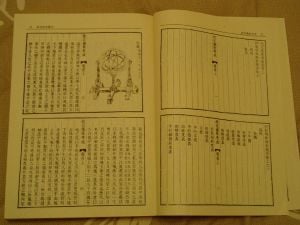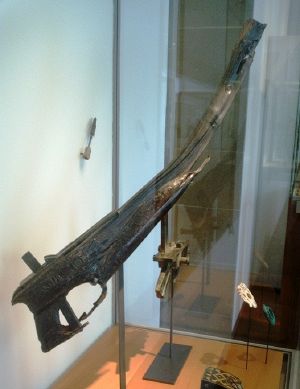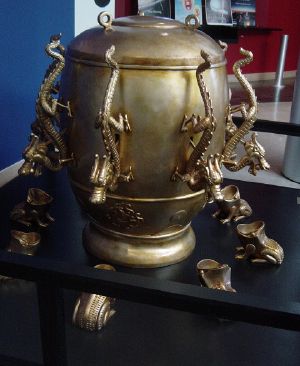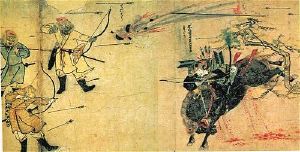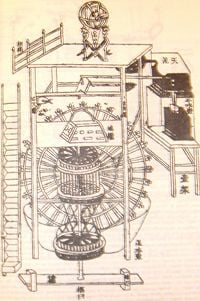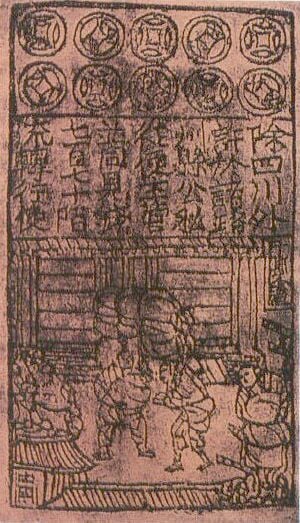History of science and technology in China
The history of science and technology in China is both long and rich with science and technological contribution. In antiquity, independent of Greek philosophers and other civilizations, ancient Chinese philosophers made significant advances in science, technology, mathematics, and astronomy. The first recorded observations of comets, solar eclipses, and supernovae were made in China.[1] Traditional Chinese medicine, acupuncture and herbal medicine were also practiced.
Among the earliest inventions were the abacus, the "shadow clock," and the first flying machines such as kites and Kongming lanterns.[2] The four Great Inventions of ancient China: the compass, gunpowder, paper making, and printing, were among the most important technological advances, only known in Europe by the end of the Middle Ages. The Tang dynasty (618 - 906 C.E.) in particular was a time of great innovation.[3] A good deal of exchange occurred between Western and Chinese discoveries up to the Qing Dynasty.
The Jesuit China missions of the sixteenth and seventeenth centuries introduced Western science and astronomy, then undergoing its own revolution, to China, and knowledge of Chinese technology was brought to Europe.[4][5] Much of the early Western work in the history of science in China was done by Joseph Needham.
Early scientific and technological achievements
One of the oldest longstanding contributions of the ancient Chinese are in Traditional Chinese medicine, including acupuncture and herbal medicine, derived from Daoist philosophy. According to archaeological findings the first writings on medicine appeared between the eleventh and the third centuries B.C.E., like the Wu Shi Er Bing Fang, Prescriptions for Fifty-Two Diseases found in a tomb excavated in 1973 near Mawangdui. The Canon of Medicine was compiled in the third century B.C.E. and summarized diagnostic knowledge like the knowledge of Bian Que, a great physician who pioneered medical examination and pulse studies.
The practice of acupuncture can be traced as far back as the first millennium B.C.E. and some scientists believe that there is evidence that practices similar to acupuncture were used in Eurasia during the early Bronze Age.[6][7] According to the History of Later Han Dynasty (25-220 C.E.), this seismograph was an urn-like instrument, which would drop one of eight balls to indicate when and in which direction an earthquake had occurred. On June 13, 2005, Chinese seismologists announced that they had created a replica of the instrument.
The mechanical engineer Ma Jun (c. 200-265 C.E.) was another impressive figure from ancient China. Ma Jun improved the design of the silk loom,[8] designed mechanical chain pumps to irrigate palatial gardens,[8] and created a large and intricate mechanical puppet theatre for Emperor Ming of Wei, which was operated by a large hidden waterwheel.[9] However, Ma Jun's most impressive invention was the South Pointing Chariot, a complex mechanical device that acted as a mechanical compass vehicle. It incorporated the use of a differential gear in order to apply equal amount of torque to wheels rotating at different speeds, a device that is found in all modern automobiles.[10]
The ancient Chinese also invented counting and time-keeping devices, which facilitated mathematical and astronomical observations. Shadow clocks, the forerunners of the sundial, first appeared in China about 4,000 years ago,[11] while the abacus was invented in China sometime between 1000 B.C.E. and 500 B.C.E.[12]
The most ancient of all astronomical instruments, at least in China, was the simple vertical pole. With this one could measure the length of the sun‚Äôs shadow by day to determine the solstices and the transits of stars by night to observe the revolution of the sidereal year.‚ÄĚ[13]
Already under the Shang dynasty (1765-1122 B.C.E.) the Chinese were casting shadows with the help of a gnomon in relation to divination.
The sundial that was much used during the Han Dynasty is clearly mentioned in the first century B.C.E. The Sundial Book which includes 34 chapters would have been compiled by Yin Hsien at that time. The use of water clock or clepsydra which was important in astronomy would go back to the Warring States period around the sixth century B.C.E. About 200 B.C.E. the outflow clepsydra was replaced by an inflow type. Water clocks were used by Zhang Heng in 125 C.E. to drive mechanisms illustrating astronomical phenomena. Later on astronomical towers were built like the tower of Su Song in 1088 that comprehended an armillary sphere, a rotating celestial globe and front panels with tablets indicating the time.
The Chinese were able to record observations, documenting the first solar eclipse in 2137 B.C.E., and making the first recording of any planetary grouping in 500 B.C.E.[1] The Book of Silk was the first definitive atlas of comets, written c. 400 B.C.E. It listed 29 comets (referred to as broom stars) that appeared over a period of about 300 years, with renderings of comets describing an event its appearance corresponded to.[1]
During the Spring and Autumn (77-476 B.C.E.) and the Warring States (475-221 B.C.E.) periods, the development of technology in agriculture and handicraft enhanced the economic activities and made crucial the means of calculation. It is then that the counting-rods and rod arithmetic were invented. The counting-rods will be used even after the invention of the abacus. The abacus or suanpan ÁģóÁõ§ was fits mentioned in the Supplementary Notes on the Art of Figures by Xu Yue, under the Han dynasty in 190 C.E., but it rose to prominence under the Yuan dynasty (1271-1368) and became a household instrument only during the Ming dynasty starting in 1368.
In architecture, the pinnacle of Chinese technology manifested itself in the Great Wall of China, under the first Chinese Emperor Qin Shi Huang between 220 B.C.E. and 200 B.C.E. Typical Chinese architecture changed little from the succeeding Han Dynasty until the nineteenth century.[14] The Great Wall as seen today is the result of grand-scale reconstruction over a period of 100 years during the Ming dynasty.
The first bridge recorded in Chinese history is the boat bridge over the river Weishui ordered by King Wen of the Zhou dynasty 3000 years ago. The first record of a stone bridge goes back to the Han dynasty. Stone-arch bridges made their appearance around 250 B.C.E. Famous bridges are the admired Anji bridge built with one arch under the Sui dynasty (581-618), the Lugou Marco Polo bridge built during the Kin dynasty (1038-1227), the jewel belt bridge, with 53 spans, built a Suzhou during the Tang dynasty. “The beam bridge has the longest history in bridge engineering whether in China or elsewhere.“ It can be mentioned for example the Luoyang bridge built during the Northern Song dynasty (960-1127) with a total length of 834 meter and a seven-meter-wide deck for traffic.[15]
The crossbow n«Ē, Śľ© was developed under the Warring States period. The followers of the philosopher Mozi (544-496) mentioned it in the fourth-third centuries B.C.E. It is also described by Sunzi in his Art of War. Several remains were found among the soldiers of the Terracotta in the tomb of emperor Shu Juangdi who unified China in 221 B.C.E.[16]
The Eastern Han Dynasty scholar and astronomer Zhang Heng (78-139 C.E.) invented the first water-powered rotating armillary sphere (the first armillary sphere however was invented by the Greek Eratosthenes), and catalogued 2500 stars and over 100 constellations. In 132, he invented the first seismological detector, called the "Houfeng Didong Yi" ("Instrument for inquiring into the wind and the shaking of the earth").[17] According to the History of Later Han Dynasty (25-220 C.E.), this seismograph was an urn-like instrument, which would drop one of eight balls to indicate when and in which direction an earthquake had occurred. On June 13, 2005, Chinese seismologists announced that they had created a replica of the instrument.
The mechanical engineer Ma Jun (c. 200-265 C.E.) was another impressive figure from ancient China. Ma Jun improved the design of the silk loom,[8] designed mechanical chain pumps to irrigate palatial gardens,[8] and created a large and intricate mechanical puppet theatre for Emperor Ming of Wei, which was operated by a large hidden waterwheel.[9] However, Ma Jun's most impressive invention was the South Pointing Chariot, a complex mechanical device that acted as a mechanical compass vehicle. It incorporated the use of a differential gear in order to apply equal amount of torque to wheels rotating at different speeds, a device that is found in all modern automobiles.[10]
Sliding calipers were invented in China almost 2000 years ago.[18] The Chinese civilization was the first civilization to succeed in exploring with aviation, with the kite and Kongming lantern (proto Hot air balloon) being the first flying machines.
The Four Great Inventions of ancient China
The "Four Great Inventions of ancient China" (Traditional Chinese: ŚõõŚ§ßÁôľśėé; Simplified Chinese: ŚõõŚ§ßŚŹĎśėé; pinyin: S√¨ d√† fńĀ m√≠ng) are the compass, gunpowder, papermaking, and printing. Paper and printing were developed first. Printing was recorded in China in the Tang Dynasty, although the earliest surviving examples of printed cloth patterns date to before 220.[19] Pinpointing the development of the compass can be difficult: the magnetic attraction of a needle is attested by the Louen-heng, composed between 20 and 100 C.E.,[20] although the first undisputed magnetized needles in Chinese literature appear in 1086.[21]
By 300 C.E., Ge Hong, an alchemist of the Jin Dynasty, conclusively recorded the chemical reactions caused when saltpetre, pine resin and charcoal were heated together in his Book of the Master of the Preservations of Solidarity.[22] Another early record of gunpowder, a Chinese book from c. 850 C.E. Classified Essentials of the Mysterious Tao of the True Origin of Things indicates that gunpowder was a byproduct of Daoist alchemical efforts to develop an elixir of immortality:[23]
Some have heated together sulfur, realgar and saltpeter with honey; smoke and flames result, so that their hands and faces have been burnt, and even the whole house where they were working burned down.[24]
These four discoveries had an enormous impact on the development of Chinese civilization and a far-ranging global impact. Gunpowder, for example, spread to the Arabs in the thirteenth century and thence to Europe.[25] According to English philosopher Francis Bacon, writing in Novum Organum:
Printing, gunpowder and the compass: These three have changed the whole face and state of things throughout the world; the first in literature, the second in warfare, the third in navigation; whence have followed innumerable changes, in so much that no empire, no sect, no star seems to have exerted greater power and influence in human affairs than these mechanical discoveries. [26]
One of the most important military treatises of all Chinese history was the Huo Long Jing written by Jiao Yu in the fourteenth century. For gunpowder weapons, it outlined the use of fire arrows and rockets, fire lances and firearms, land mines and naval mines, bombards and cannons, along with different compositions of gunpowder, including 'magic gunpowder', 'poisonous gunpowder', and 'blinding and burning gunpowder.' (refer to his article).
For the eleventh century invention of ceramic movable type printing by Bi Sheng (990-1051), it was enhanced by the wooden movable type of Wang Zhen in 1298 and the bronze metal movable type of Hua Sui in 1490.
The Middle Ages
Among the scientific accomplishments of early China were matches, dry docks, the double-action piston pump, cast iron, the iron plough, the horse collar, the multi-tube seed drill, the wheelbarrow, the suspension bridge, the parachute, natural gas as fuel, the raised-relief map, the propeller, the sluice gate, and the pound lock. The Tang Dynasty (618 - 906 C.E.) in particular was a time of great innovation.
In the seventh century, book-printing was developed in China and Japan, using delicate hand-carved wooden blocks to print individual pages. The ninth century Diamond Sutra is the earliest known printed document. Movable type was also used in China for a time, but was abandoned because of the number of characters needed; it would not be until Gutenberg (1400-1468) that the technique was reinvented in a suitable environment.[27]
In addition to gunpowder, the Chinese also developed improved delivery systems for the Byzantine weapon of Greek fire, Meng Huo You and Pen Huo Qi first used in China c. 900.[28] Chinese illustrations were more realistic than in Byzantine manuscripts,[28] and detailed accounts from 1044 recommending its use on city walls and ramparts show the brass container as fitted with a horizontal pump, and a nozzle of small diameter.[28] The records of a battle on the Yangtze near Nanjing in 975 offer an insight into the dangers of the weapon, as a change of wind direction blew the fire back onto the Song forces.[28]
The Song Dynasty (960-1279) brought a new stability for China after a century of civil war, and started a new area of modernization by encouraging examinations and meritocracy. The first Song Emperor created political institutions that allowed a great deal of freedom of discourse and thought, which facilitated the growth of scientific advance, economic reforms, and achievements in arts and literature.[29] Trade flourished both within China and overseas, and the encouragement of technology allowed the mints at Kaifeng and Hangzhou to gradually increase in production. In 1080, the mints of Emperor Shenzong were produced five billion coins (roughly 50 per Chinese citizen), and the first banknotes were produced in 1023. These coins were so durable that they would still be in use 700 years later, in the eighteenth century.
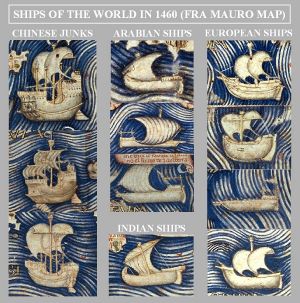
There were many famous inventors and early scientists in the Song Dynasty period. The statesman Shen Kuo is best known for his book known as the Dream Pool Essays (1088 C.E.). In it, he wrote of use for a drydock to repair boats, the navigational magnetic compass, and the discovery of the concept of true north (with magnetic declination towards the North Pole). Shen Kuo also devised a geological theory for land formation, or geomorphology, and theorized that there was climate change in geological regions over an enormous span of time. The equally talented statesman Su Song was best known for his engineering project of the Astronomical Clock Tower of Kaifeng, by 1088 C.E. The clock tower was driven by a rotating waterwheel and escapement mechanism, the latter of which did not appear in clockworks of Europe until two centuries later. Crowning the top of the clock tower was the large bronze, mechanically-driven, rotating armillary sphere. In 1070, Su Song also compiled the Ben Cao Tu Jing (Illustrated Pharmacopoeia, original source material from 1058 ‚Äď 1061 C.E.) with a team of scholars. This pharmaceutical treatise covered a wide range of other related subjects, including botany, zoology, mineralogy, and metallurgy.
Chinese astronomers were also among the first to record observations of a supernova, in 1054, making the Crab Nebula the first astronomical object recognized as being connected to a supernova explosion.[30] Arabic and Chinese astronomy intermingled under the Mongol rule of the Yuan Dynasty. Muslim astronomers worked in the Chinese astronomical bureau established by Kublai Khan, while some Chinese astronomers also worked at the Persian Maragha observatory.[31] (Before this, in ancient times, Indian astronomers had lent their expertise to the Chinese court.[3]) Mongol rule also saw technological advances from an economic perspective, with the first mass production of paper banknotes by Kublai Khan in the eleventh century.[32]
Jesuit activity in China
The Jesuit China missions of the sixteenth and seventeenth centuries introduced Western science and astronomy, then undergoing its own revolution, to China. The Society of Jesus introduced, according to Thomas Woods, "a substantial body of scientific knowledge and a vast array of mental tools for understanding the physical universe, including the Euclidean geometry that made planetary motion comprehensible."[33] Another expert quoted by Woods said the scientific revolution brought by the Jesuits coincided with a time when science was at a very low level in China:
[The Jesuits] made efforts to translate western mathematical and astronomical works into Chinese and aroused the interest of Chinese scholars in these sciences. They made very extensive astronomical observation and carried out the first modern cartographic work in China. They also learned to appreciate the scientific achievements of this ancient culture and made them known in Europe. Through their correspondence European scientists first learned about the Chinese science and culture.[34]
Scientific and technological stagnation
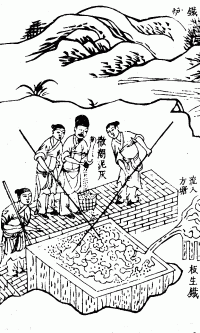
One question that has been the subject of debate among historians has been why China did not develop a scientific revolution and why Chinese technology fell behind that of Europe. Many hypotheses have been proposed ranging from the cultural to the political and economic. Sinologist Nathan Sivin has argued that China indeed had a scientific revolution in the seventeenth century and that we are still far from understanding the scientific revolutions of the West and China in all their political, economic and social ramifications.[35] John K. Fairbank argued that the Chinese political system was hostile to scientific progress.
Needham argued, and most scholars agreed, that cultural factors prevented these Chinese achievements from developing into what could be called "science".[36] It was the religious and philosophical framework of the Chinese intellectuals which made them unable to believe in the ideas of laws of nature:
It was not that there was no order in nature for the Chinese, but rather that it was not an order ordained by a rational personal being, and hence there was no conviction that rational personal beings would be able to spell out in their lesser earthly languages the divine code of laws which he had decreed afore time. The Taoists, indeed, would have scorned such an idea as being too na√Įve for the subtlety and complexity of the universe as they intuited it.[37]
Similar grounds have been found for questioning much of the philosophy behind traditional Chinese medicine, which, derived mainly from Daoist philosophy, reflects the classical Chinese belief that individual human experiences express causative principles effective in the environment at all scales. Because its theory predates use of the scientific method, it has received various criticisms based on scientific thinking. Even though there are physically verifiable anatomical or histological bases for the existence of acupuncture points or meridians, for instance skin conductance measurements show increases at the predicted points[38]), philosopher Robert Todd Carroll, a member of the Skeptics Society, deemed acupuncture a pseudoscience because it "confuse(s) metaphysical claims with empirical claims."
…no matter how it is done, scientific research can never demonstrate that unblocking chi by acupuncture or any other means is effective against any disease. Chi is defined as being undetectable by the methods of empirical science.[39]
More recent historians have questioned political and cultural explanations and have focused more on economic causes. Mark Elvin's high level equilibrium trap is one well-known example of this line of thought, as well as Kenneth Pomeranz' argument that resources from the New World made the crucial difference between European and Chinese development. Other events such as Haijin and Cultural Revolution have isolated China during critical times.
Science and technology in the People's Republic of China
Science and technology in the People's Republic of China is growing rapidly. As the People's Republic of China has become better connected to the global economy, the government has placed more emphasis on science and technology. This has led to increases in funding, improved scientific structure, and more money for research. These factors have led to advancements in agriculture, medicine, genetics, and global change.
See also
- List of Chinese inventions
- Chinese mathematics
- Chinese astronomy
- Science and technology in the People's Republic of China
- Traditional Chinese medicine
Notes
- ‚ÜĎ 1.0 1.1 1.2 Ancient Chinese Astronomy cwru.edu.
- ‚ÜĎ Eryl Davies. Inventions. (Pocket Editions) (London: Dorling Kindersley, 1995. ISBN 9781564588890)
- ‚ÜĎ Davies
- ‚ÜĎ Thomas E. Woods. How the Catholic Church built Western civilization. (Washington, DC: Regnery Pub., 2005. ISBN 9780895260383)
- ‚ÜĎ Agust√≠n Ud√≠as Vallina. Searching the heavens and the earth: the history of Jesuit observatories. (Astrophysics and space science library, v. 286). (Dordrecht: Kluwer Academic Publishers, 2003. ISBN 9781402011894), 53
- ‚ÜĎ Some say that acupuncture originated out of the practice of treating a patient by stimulating parts of the body with stone slivers. Metallic pins began to be used in the eighth century B.C.E., and gold pins in the third century B.C.E. Two medical works were composed to explain acupuncture techniques, The Yellow Emperor's Classic in Acupuncture and Moxibustion in the third century B.C.E. and A Classic of Acupuncture and Moxibustion in the third century C.E. Between the fourth and tenth centuries therapeutic techniques of acupuncture were enriched. Around the sixth century C.E. acupuncture was introduced in Korea and in Japan. A medical report from the stone age? in The Lancet [1]".The Lancet 354 (9183) (Sept 18, 1999): 1023 - 1025. (subscription required).
- ‚ÜĎ "China resurrects world's earliest seismograph," June 13, 2005, People's Daily Online.
- ‚ÜĎ 8.0 8.1 8.2 8.3 Needham, Volume 4, Part 2, 39.
- ‚ÜĎ 9.0 9.1 Needham, Volume 4, Part 2, 158.
- ‚ÜĎ 10.0 10.1 Needham, Volume 4, Part 2, 40.
- ‚ÜĎ Davies
- ‚ÜĎ Jesse Dilson. The Abacus: The World's First Computing System: Where it Comes From, How it Works, and How to Use it to Perform Mathermatical Feats Great and Small. (St. Martin's Griffin, 2997. ISBN 978-0312104092)
- ‚ÜĎ Joseph Needham. Science and Civilization in China, Volume 3, 384
- ‚ÜĎ Philip Wilkinson. Buildings. Pockets. (London: Dorling Kindersley, 1995. ISBN 9781564588852).
- ‚ÜĎ Zhongguo ke xue yuan. Ancient China's technology and science. (China knowledge series). (Beijing: Foreign Languages Press, 1983. ISBN 9780835110013)
- ‚ÜĎ The Qin Dynasty online Source Book. Weapons of the terracotta army.
- ‚ÜĎ "China resurrects world's earliest seismograph." June 13, 2005, People's Daily Online
- ‚ÜĎ Davies
- ‚ÜĎ Shelagh Vainker. 2003. "Costumes of China." Orientations 34 (9):52. OCLC: 97633608
- ‚ÜĎ "A lodestone attracts a needle." Li Shu-hua, ‚ÄúOrigine de la Boussole 11. Aimant et Boussole,‚ÄĚ Isis 45 (2) (Jul. 1954): 176
- ‚ÜĎ Li Shu-hua, 175
- ‚ÜĎ Liang, Appendix C VII
- ‚ÜĎ Jack Kelly. Gunpowder: alchemy, bombards, and pyrotechnics: the history of the explosive that changed the world. (New York: Basic Books, 2004. ISBN 9780465037186), 3
- ‚ÜĎ Kelly, 4
- ‚ÜĎ Kelly, 22. "Around 1240 the Arabs acquired knowledge of saltpeter (‚ÄúChinese snow‚ÄĚ) from the East, perhaps through India. They knew of gunpowder soon afterward. They also learned about fireworks (‚ÄúChinese flowers‚ÄĚ) and rockets (‚ÄúChinese arrows‚ÄĚ)."
- ‚ÜĎ Novum Organum, Liber I, CXXIX - Adapted from the 1863 translation
- ‚ÜĎ Davies
- ‚ÜĎ 28.0 28.1 28.2 28.3 Stephen R. Turnbull and Peter Dennis. "The walls of Constantinople AD 324-1453. Fortress 25. (Oxford: Osprey Publishing, 2004. ISBN 9781841767598), 43
- ‚ÜĎ Money of the World, Special Christmas Edition, (Orbis Publishing Ltd, 1998).
- ‚ÜĎ Nicholas U. Mayall, 1939. The Crab Nebula, a Probable Supernova, Astronomical Society of the Pacific Leaflets, v. 3, 145
- ‚ÜĎ Benno Van Dalen, "Islamic and Chinese Astronomy under the Mongols: a Little-Known Case of Transmission," in Yvonne Dold-Samplonius, Joseph W. Dauben, Menso Folkerts & Benno van Dalen, (eds.) From China to Paris. 2000 Years Transmission of Mathematical Ideas. (Series: Boethius 46), (Stuttgart: Steiner, 2002), 327-356. abstract in Abstracta Iranica
- ‚ÜĎ Davies
- ‚ÜĎ Woods
- ‚ÜĎ Ud√≠as, 53
- ‚ÜĎ Nathan Sivin's Curriculum Vitae. Univ. of Pennsylvania.
- ‚ÜĎ Woods
- ‚ÜĎ Joseph Needham. The Grande Titration. (Toronto: U. of Toronto Press, 1969), 581.
- ‚ÜĎ Robert O. Becker, M.D. The Body Electric: Electromagnetism and the Foundation of Life. (Harper Paperbacks, 1998. ISBN 0688069711), 233-236
- ‚ÜĎ Robert T. Carroll, "Acupuncture" in The Skeptic's Dictionary, [2]. skeptic.com.
All links Retrieved July 11, 2009.
ReferencesISBN links support NWE through referral fees
- Becker, Robert O. The Body Electric: Electromagnetism and the Foundation of Life. (original 1985) (Harper Paperbacks, 1998. ISBN 0688069711.
- Davies, Eryl. Inventions. (Pocket Editions) London: Dorling Kindersley, 1995. ISBN 9781564588890
- Dilson, Jesse. The Abacus: The World's First Computing System: Where it Comes From, How it Works, and How to Use it to Perform Mathermatical Feats Great and Small. St. Martin's Griffin, 2997. ISBN 978-0312104092.
- Fairbank, John King, and Merle Goldman. China: A New History. Cambridge: MA; London: The Belknap Press of Harvard University Press, 2nd ed., 2006. ISBN 0674018281.
- Kelly, Jack. 'Gunpowder: alchemy, bombards, and pyrotechnics: the history of the explosive that changed the world. New York: Basic Books, 2004. ISBN 9780465037186
- Li Shu-hua, "Origine de la Boussole 11. Aimant et Boussole," Isis 45 (2) (Jul. 1954): 175.
- Needham, Joseph. 1954. Science and civilization in China. Cambridge [Eng.]: University Press. OCLC: 412338
- Needham, Joseph, Peng Yoke Ho, Gwei-Djen Lu, and Ling Wang. 1986. Science and civilisation in China. Taipei, Taiwan: Caves Books. OCLC: 48999277
- Needham, Joseph. The Grande Titration. Toronto: U. of Toronto Press, 1969.
- Sivin, Nathan. Science in Ancient China: Researches and Reflections. (rookfield, VT: VARIORUM, Ashgate Publishing, 1995.
- Turnbull, Stephen R., and Peter Dennis. 2004. "The walls of Constantinople AD 324-1453." Fortress 25. Oxford: Osprey Publishing. ISBN 9781841767598
- Udías Vallina, Agustín. 2003. Searching the heavens and the earth: the history of Jesuit observatories. (Astrophysics and space science library, v. 286.) Dordrecht: Kluwer Academic Publishers. ISBN 9781402011894
- Vainker, Shelagh. 2003. "Costumes of China." Orientations 34 (9):52. OCLC: 97633608
- Van Dalen, Benno, "Islamic and Chinese Astronomy under the Mongols: a Little-Known Case of Transmission," in Yvonne Dold-Samplonius, Joseph W. Dauben, Menso Folkerts & Benno van Dalen, (eds.) From China to Paris. 2000 Years Transmission of Mathematical Ideas. (Series: Boethius 46), (Stuttgart: Steiner, 2002), 327-356. abstract in Abstracta Iranica
- Whitfield, Roderick, Anne Farrer, S. J. Vainker, and Jessica Rawson. 1990. Caves of the thousand Buddhas: Chinese art from the silk route. New York: George Braziller. ISBN 9780807612491
- Woods, Thomas E. 2005. How the Catholic Church built Western civilization. Washington, DC: Regnery Pub. ISBN 9780895260383
| ||||||||
Credits
New World Encyclopedia writers and editors rewrote and completed the Wikipedia article in accordance with New World Encyclopedia standards. This article abides by terms of the Creative Commons CC-by-sa 3.0 License (CC-by-sa), which may be used and disseminated with proper attribution. Credit is due under the terms of this license that can reference both the New World Encyclopedia contributors and the selfless volunteer contributors of the Wikimedia Foundation. To cite this article click here for a list of acceptable citing formats.The history of earlier contributions by wikipedians is accessible to researchers here:
The history of this article since it was imported to New World Encyclopedia:
Note: Some restrictions may apply to use of individual images which are separately licensed.
